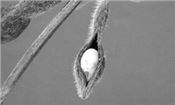|
Wet Weather Can Cause Seeds To Sprout On The Plant
DR. WILLIAM J. WIEBOLD
COLUMBIA, MO.
Corn and soybean seeds possess several mechanisms that prevent sprouting before maturity. The primary mechanism is a balance between two growth hormones, gibberellic acid (GA) and abscisic acid (ABA). In general, GA promotes germination and ABA inhibits germination. The concentrations of ABA in corn and soybean seeds peak during the middle of seed filling and begin to decrease as the seeds near maturity. Before maturity, seeds are prevented from germinating even though water content and other factors would stimulate germination. After maturing, seeds of most of our grain crops are capable of germinating if conditions are favorable. Unfortunately, this also means that, seeds from normal corn and soybean plants can germinate on the ear or in the pod if certain weather events occur.
The two primary requirements for seed germination are temperature and moisture. The minimum temperature for corn and soybean seed germination is about 50°F or a little cooler. Germination can occur within a couple of days with temperatures in the 80s. This year has provided abundant number of days with temperatures conducive to rapid germination. So, the primary factor that should reduce seed germination on the plant is moisture. Critical grain moistures that stimulate germination are 30 to 50 percent, depending on crop. In normal years, grain dries as it matures to moisture percentages far below requirements for germination. Unfortunately, weather in late summer and early fall has included heavy rain events and heavy, long-lasting dews.
Normally, corn husks protect mature kernels from moisture that may cause germination. If the ear turns downward at maturity, the husks shed water and the chances of kernels sprouting on the ear are almost eliminated. But, if the ear remains upward, water from rain or even a heavy dew may run down the inside of the husks and pool at the butt end of the ear. Husks trap water near the kernels and if temperatures are above 50°F kernels will likely germinate. Sprouting on the ear is almost always limited to several rows of kernels at the butt end of the ear because this is where water is trapped. But, this year occurrences of rainfalls greater than several inches may have allowed water levels in upright ears to rise higher on the ear.
For soybean, the pod wall helps prevent mature soybean seeds from absorbing water by shedding rain water. Frequent rains, continuous drizzle, or foggy days and nights can bathe the soybean pod in enough water that the water soaks through the pod wall and wets the soybean seed.
A more common reason for soybean seeds sprouting in the pod is that the pod wall has separated or broken. This allows water access to the seeds. During wetting and drying cycles, mature soybean seeds expand and contract. Expanding seeds exert heavy pressure on the soybean pod wall. Soybean pods walls do not expand as much as soybean seeds. The two halves of the pod wall are sutured together and these sutures can rupture if enough pressure is provided by expanding seeds. If the two halves of the pod wall separate and the seed dries and shrinks, the seed may fall from the pod. This is called shattering.
Under wet conditions, the soybean seed remains swollen and will not fall from the pod. But, the now exposed seed will likely germinate if it remains wet long enough and if the temperature is above the minimum.
Premature sprouting is quite damaging to grain quality and reduces safe storage time. During germination, seeds release enzymes that break down carbohydrates, proteins and fats. This breakdown releases free sugars, amino acids, and fatty acids. These simple compounds spoil easily in storage and stimulate fungal growth. The soybean seed coat and the corn kernel pericarp rupture during germination, and this makes the grain vulnerable to invasion by fungi and insects. Germinated seeds will crack during combining. Debris from sprouted seeds will often accumulate in the center of a bin and may be a fire hazard.
Unfortunately, sprouted seeds is a permanent damage to grain. Spread of the damage can be reduced by timely harvest and quick drying of grain to stop germination and grain deterioration. If possible, grain should be screened to remove debris before storage. Be aware that dockage at the point of sale may reduce grain price. ∆
DR. WILLIAM J. WIEBOLD: Agronomy Professor, University of Missouri

Kernel sprouting in corn

Separated soybean pod

Premature soybean germination
|
|